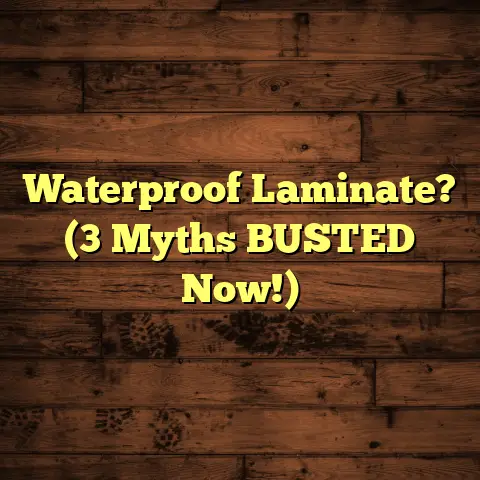Removing Paint From Wood Floors (2 Methods!)
And let me tell you, I’ve seen my fair share of paint spills on beautiful wood floors.
It’s a common problem, right?
Whether it’s a rogue brush during a DIY project or a clumsy mishap, paint happens.
But don’t panic!
Unsightly paint stains don’t have to ruin the aesthetic and value of your wood floors.
The good news is, there are ways to tackle this problem, even if you’re on a tight budget.
In this article, I’m going to walk you through two effective methods for removing paint from wood floors, keeping your budget in mind.
We’ll explore DIY solutions using household items and delve into the world of chemical paint removers.
By the end, you’ll be equipped with the knowledge to choose the best approach for your situation and restore your floors to their former glory.
Ready to dive in? Let’s get started!
Understanding the Importance of Budgeting
Before we get our hands dirty, let’s talk about money.
Home improvement projects can quickly drain your wallet if you’re not careful.
That’s why budgeting is crucial, especially when dealing with something like paint removal.
Several factors can influence the cost of removing paint from wood floors.
These include:
- Size of the affected area: A small splatter is way easier (and cheaper) to deal with than a large spill.
- Type of paint: Oil-based paints are generally more stubborn and require stronger (and often pricier) solutions.
- Condition of the wood floor: Older, more delicate floors might require gentler (and potentially more time-consuming) methods.
Now, you have two main options: DIY or hiring a professional.
Let’s break down the potential costs associated with each:
DIY:
- Pros: Significantly cheaper, especially if you use household supplies.
- Cons: Can be time-consuming, requires elbow grease, and might not be effective for tough stains.
Hiring a Professional:
- Pros: Saves you time and effort, ensures the job is done correctly, and minimizes the risk of damaging your floors.
- Cons: Can be expensive, depending on the scope of the project and the contractor’s rates.
According to a recent survey by HomeAdvisor, the average cost to refinish wood floors ranges from $3 to $8 per square foot.
This includes sanding and applying a new finish, which might be necessary after paint removal.
But don’t let that scare you!
Many homeowners have successfully tackled paint removal on a budget.
For example, my friend Sarah had a nasty paint spill in her living room.
Instead of hiring a professional, she opted for a DIY approach using vinegar and baking soda.
It took some time and effort, but she saved a ton of money and was thrilled with the results.
The key is to assess your situation, consider your budget, and choose the method that best suits your needs.
Don’t be afraid to do your research and get creative!
DIY Method 1 – Using Household Supplies
Alright, let’s get into our first DIY method: using common household supplies.
This is a great option if you’re on a tight budget or prefer a more natural approach.
Here’s a step-by-step guide:
Materials Needed:
- Warm water
- Dish soap
- White vinegar
- Baking soda
- Soft cloths or sponges
- Plastic scraper (optional)
- Vacuum cleaner or broom
Step 1: Preparation
Start by sweeping or vacuuming the area to remove any loose debris.
You don’t want to grind dirt into the paint stain while you’re trying to clean it.
Step 2: Gentle Cleaning
Mix a small amount of dish soap with warm water.
Dip a soft cloth or sponge into the solution and gently wipe the paint stain.
This will help to loosen the paint and remove any surface dirt.
Step 3: Vinegar Power
If the dish soap isn’t doing the trick, try vinegar.
Vinegar is a natural solvent that can help to break down paint.
Mix equal parts white vinegar and warm water.
Apply the solution to the paint stain and let it sit for a few minutes.
Then, gently scrub with a soft cloth or sponge.
Step 4: Baking Soda Scrub
For more stubborn stains, baking soda can be your secret weapon.
Make a paste of baking soda and water.
Apply the paste to the paint stain and let it sit for a few minutes.
Then, gently scrub with a soft cloth or sponge.
You can also use a plastic scraper to carefully lift the paint.
Be careful not to scratch the wood!
Step 5: Rinse and Dry
Once you’ve removed the paint, rinse the area with clean water.
Dry the area thoroughly with a clean cloth.
Important Note: Always test any cleaning solution in an inconspicuous area first to make sure it doesn’t damage the finish of your wood floor.
Safety Precautions:
- Ventilation: Make sure the area is well-ventilated while you’re working.
- Gloves: Wear gloves to protect your hands from irritation.
- Eye Protection: Wear eye protection to prevent splashes from getting into your eyes.
Cost Analysis:
The cost of this method is minimal.
You likely already have most of these supplies in your home.
Even if you need to buy vinegar and baking soda, it’ll only cost you a few dollars.
Here’s a quick breakdown of the estimated costs:
| Item | Estimated Cost |
|---|---|
| Vinegar | \$2 – \$5 |
| Baking Soda | \$1 – \$3 |
| Dish Soap | On Hand |
| Total | \$3 – \$8 |
As you can see, this method is incredibly affordable.
I’ve personally used this method on several occasions, especially for small paint splatters.
It’s gentle, effective, and doesn’t involve harsh chemicals.
Just remember to be patient and persistent, and you’ll be amazed at the results.
DIY Method 2 – Chemical Paint Removers
Now, let’s move on to our second DIY method: using chemical paint removers.
This option is more aggressive and is best suited for stubborn paint stains or larger areas.
Step-by-Step Guide:
Step 1: Choose the Right Paint Remover
There are several types of paint removers available, including:
- Solvent-based: These are the strongest and most effective, but they also have the strongest fumes.
- Biodegradable: These are more environmentally friendly and have milder fumes, but they might not be as effective on tough stains.
- Gel-based: These are ideal for vertical surfaces because they don’t drip as easily.
Choose the right paint remover based on the type of paint and wood finish.
Read the product label carefully and follow the manufacturer’s instructions.
Step 2: Preparation
Protect the surrounding area with drop cloths or plastic sheeting.
This will prevent the paint remover from damaging other surfaces.
Step 3: Application
Apply the paint remover to the paint stain using a brush or applicator.
Apply a thick, even coat.
Step 4: Waiting Time
Let the paint remover sit for the amount of time recommended on the product label.
This will allow the remover to penetrate the paint and loosen its bond with the wood.
Step 5: Scraping
Use a plastic scraper to carefully scrape off the softened paint.
Work in small sections and be careful not to gouge or scratch the wood.
Step 6: Clean Up
Once you’ve removed all the paint, clean the area with a damp cloth.
Follow the manufacturer’s instructions for cleaning up the paint remover residue.
Step 7: Neutralize (If Necessary)
Some paint removers require neutralization after use.
Check the product label for instructions.
Safety Precautions:
- Ventilation: Ensure adequate ventilation by opening windows and doors.
- Gloves: Wear chemical-resistant gloves to protect your hands.
- Mask: Wear a respirator or mask to avoid inhaling fumes.
- Eye Protection: Wear goggles or a face shield to protect your eyes.
Cost Analysis:
The cost of this method is higher than using household supplies.
Chemical paint removers can range in price from \$15 to \$50 per quart, depending on the type and brand.
Here’s a quick breakdown of the estimated costs:
| Item | Estimated Cost |
|---|---|
| Paint Remover | \$15 – \$50 |
| Gloves | \$5 – \$10 |
| Mask/Respirator | \$10 – \$30 |
| Drop Cloths/Sheeting | \$5 – \$15 |
| Total | \$35 – \$105 |
While this method is more expensive, it can be more effective for tough stains and larger areas.
Just remember to prioritize safety and follow the manufacturer’s instructions carefully.
In my experience, chemical paint removers can be a lifesaver when dealing with stubborn paint stains.
However, I always emphasize the importance of safety precautions.
These chemicals can be harsh, so it’s crucial to protect yourself and your home.
Comparing the Two Methods
Now that we’ve covered both DIY methods, let’s compare them side-by-side:
| Feature | DIY Method 1 (Household Supplies) | DIY Method 2 (Chemical Paint Removers) |
|---|---|---|
| Cost | Very Affordable | More Expensive |
| Effectiveness | Good for Light Stains | Good for Tough Stains |
| Safety | Relatively Safe | Requires Strict Safety Precautions |
| Time | More Time-Consuming | Less Time-Consuming |
| Environmental Impact | Lower | Higher |
When to Use Which Method:
- Small, fresh paint splatters: Start with household supplies.
- Large, dried paint spills: Consider chemical paint removers.
- Delicate wood floors: Opt for the gentler household supplies method.
- Tough, oil-based paint: Chemical paint removers might be necessary.
- Budget constraints: Household supplies are the way to go.
- Time constraints: Chemical paint removers can save you time.
Ultimately, the best method depends on your individual circumstances.
Consider the severity of the paint spill, the type of wood flooring, your skill level, and your budget.
I’ve seen homeowners successfully use both methods.
The key is to be informed, prepared, and patient.
Don’t be afraid to experiment and find what works best for you.
Final Thoughts
Removing paint from wood floors can be a daunting task, but it doesn’t have to break the bank.
By understanding your budget options and the available methods, you can tackle this problem with confidence.
Remember these key points:
- Budgeting is crucial for any home improvement project.
- DIY methods can save you money, but they require time and effort.
- Chemical paint removers are more effective for tough stains, but they require strict safety precautions.
- Choose the method that best suits your needs and budget.
Before you start, assess your situation, consider your available resources, and do your research.
Don’t be afraid to ask for help or consult with a professional if you’re unsure.
I’ve always believed that maintaining wood floors is an investment in your home.
By taking the time to remove paint stains and restore your floors, you’re not only improving the aesthetic appeal of your home but also increasing its value.
Conclusion
So, there you have it!
Two effective methods for removing paint from wood floors, keeping your budget in mind.
I hope this article has provided you with the knowledge and confidence to tackle this project yourself.
Remember, maintaining your wood floors is an investment, and the satisfaction of restoring them to their former glory is well worth the effort.
Now go forth, assess your situation, consider your resources, and get those floors looking their best!
You got this!





